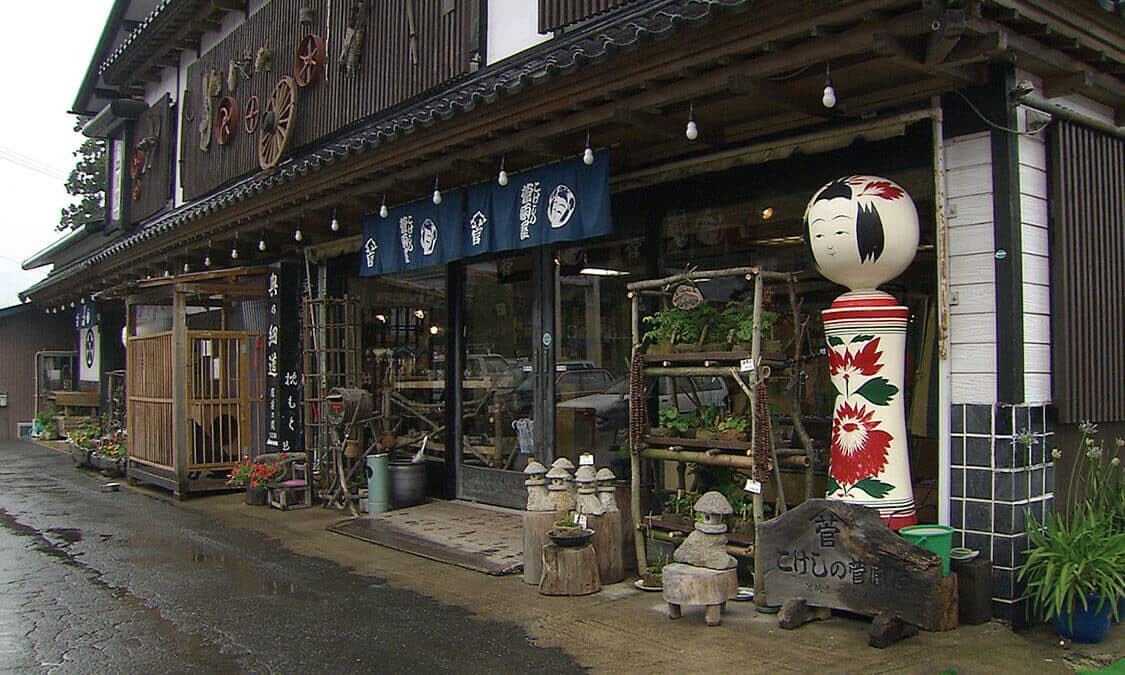![Kokeshi doll - こけし - [Folktoy | Charm]](http://samkalensky.com/cdn/shop/files/09DE6191-0C83-4AB0-850D-AB7350879A5D_{width}x.jpg?v=1746570019)
Kokeshi dolls. - こけし - [Folktoy | Charm | Haunted Doll?]
• About this Doll: Kokeshi are simple wooden dolls carved with a lathe & hand painted (no two are exactly alike!) they have been sold as souvenirs at Tohoku Onsens (hot springs) across north eastern japan since the Edo period. There was a time where traditionally, each and every Onsen would have their own signature Kokeshi doll for sale.
There are several slight charming variations in both shape and design,so the dolls are very collectible, the bottom of each doll has a makers signature/stamp showing where they where made. – There are entire books, blogs & websites dedicated to cataloguing & identifying where each style of doll came from. - The one I drew is inspired by the ones made at the famous Naruko onsen in Miyagi Prefecture which famously has a 'kokeshi street' & annual festival too.'

[traditional styles of kokeshi from across japan via international folkart museum]
 [naruko onsens famous kokeshi shop]
[naruko onsens famous kokeshi shop]
• In modern Horror stories & Urban Legends: Although its quite the common trope in modern folklore & urban legends to say that 'The dolls where created in dedication or memory of a culled, dead or unborn child.' This is simply a myth or an urban legend. - Kokeshi have been highly prized mostly by the older generation of toy collectors for generations now. - so, they might unintentionally give off that 'Tsukumogami ('haunted antique') vibe' to younger generations which may find them kinda eerie. - (As I've said before anything in excess numbers can be quite scary!) Some older collectors might have entire shelves or even rooms dedicated to their collections of Kokeshi. So, it might come off unintentionally terrifying to younger folk. At least out of context. Hence the horror trope!

[a collection of kokeshi dolls, photo via kowabana, check them out for a spooky story about a kokeshi collection.]
Historians & folklorists alike have pointed out that the opposite is much more likely: That is to say that these toys were in fact made & manufactured for someone to play with or keep as a memento of their trip; after-all end of the day, they're just cute souvenirs! - Although their false association with child culling may not be true. - The opposite - might be! - The choice of 'red' could very well be related to the "Red treatment & Aka-e charms" a belief that thrived during the edo period small pox epidemics; the auspicious colour was believed to ward away disease spreading small pox demons (hosogami.) - as such; Aka-e became a popular theme in both folklore, art & souvenirs all across Japan. [(for more on that: see my Aka-e charms section.)]
Because of their association with such rumours; Kokeshi often appear in modern ghost stories; usually ones about 'Zashiki Warashi.' (Ghost children that bring good luck and reside in Zashiki guestrooms.)
For yet another modern story about a "Cursed Kokeshi doll" see the urban legend of the 'Uzudoll.' (who's general design seems to be inspired by modern shingata-kokeshi.)
• see also: Okiku doll.

[art sticker by samkalensky part of my folktoys and charm collections! follow and support for many more!]

![Kokeshi doll - こけし - [Folktoy | Charm]](http://samkalensky.com/cdn/shop/files/7598ACA1-DA04-4847-BBE7-2F698C96EC37_{width}x.jpg?v=1746570019)
![Kokeshi doll - こけし - [Folktoy | Charm]](http://samkalensky.com/cdn/shop/files/D2951732-807A-47E8-8E6F-5939BD33F0D1_{width}x.jpg?v=1746570019)
![Kokeshi doll - こけし - [Folktoy | Charm]](http://samkalensky.com/cdn/shop/files/9F71C873-46DD-4CAC-A0B6-AEE2D48B6C26_{width}x.jpg?v=1746569239)
![Kokeshi doll - こけし - [Folktoy | Charm]](http://samkalensky.com/cdn/shop/files/54B67C08-C4A8-454C-BFBF-7710F1BBA376_{width}x.jpg?v=1746569239)
![Kokeshi doll - こけし - [Folktoy | Charm]](http://samkalensky.com/cdn/shop/files/109C23B5-192C-4BC2-93B3-DA4237366F83_{width}x.jpg?v=1746568232)
![Kokeshi doll - こけし - [Folktoy | Charm]](http://samkalensky.com/cdn/shop/files/C3B52B7D-57A1-48A1-9A07-799890D595D1_{width}x.jpg?v=1746568232)
![Kokeshi doll - こけし - [Folktoy | Charm]](http://samkalensky.com/cdn/shop/files/06290671-D2F4-4321-BFA6-C546623E017E_{width}x.jpg?v=1746568232)
![Kokeshi doll - こけし - [Folktoy | Charm]](http://samkalensky.com/cdn/shop/files/9C74E622-734C-41E1-8A28-EBBC359DDEC8_{width}x.jpg?v=1746568232)
![Kokeshi doll - こけし - [Folktoy | Charm]](http://samkalensky.com/cdn/shop/files/29DCED7D-F931-4DCF-8757-BA5FF301DCE5_{width}x.jpg?v=1746568232)
![Kokeshi doll - こけし - [Folktoy | Charm]](http://samkalensky.com/cdn/shop/files/6C12E458-1E5B-4DEF-A046-818D079DB05F_{width}x.jpg?v=1746568232)
![Kokeshi doll - こけし - [Folktoy | Charm]](http://samkalensky.com/cdn/shop/files/9A11078B-9778-406F-8923-757B77175C57_{width}x.jpg?v=1746568232)
![Kokeshi doll - こけし - [Folktoy | Charm]](http://samkalensky.com/cdn/shop/files/41F01B48-005B-48A4-BD75-84D257B7DACB_{width}x.jpg?v=1746568232)
![Kokeshi doll - こけし - [Folktoy | Charm]](http://samkalensky.com/cdn/shop/files/A4330BBC-FD0F-4405-A13A-D2DD937936F2_{width}x.jpg?v=1746568232)
![Load image into Gallery viewer, Kokeshi doll - こけし - [Folktoy | Charm]](http://samkalensky.com/cdn/shop/files/09DE6191-0C83-4AB0-850D-AB7350879A5D_110x110@2x.jpg?v=1746570019)
![Load image into Gallery viewer, Kokeshi doll - こけし - [Folktoy | Charm]](http://samkalensky.com/cdn/shop/files/7598ACA1-DA04-4847-BBE7-2F698C96EC37_110x110@2x.jpg?v=1746570019)
![Load image into Gallery viewer, Kokeshi doll - こけし - [Folktoy | Charm]](http://samkalensky.com/cdn/shop/files/D2951732-807A-47E8-8E6F-5939BD33F0D1_110x110@2x.jpg?v=1746570019)
![Load image into Gallery viewer, Kokeshi doll - こけし - [Folktoy | Charm]](http://samkalensky.com/cdn/shop/files/9F71C873-46DD-4CAC-A0B6-AEE2D48B6C26_110x110@2x.jpg?v=1746569239)
![Load image into Gallery viewer, Kokeshi doll - こけし - [Folktoy | Charm]](http://samkalensky.com/cdn/shop/files/54B67C08-C4A8-454C-BFBF-7710F1BBA376_110x110@2x.jpg?v=1746569239)
![Load image into Gallery viewer, Kokeshi doll - こけし - [Folktoy | Charm]](http://samkalensky.com/cdn/shop/files/109C23B5-192C-4BC2-93B3-DA4237366F83_110x110@2x.jpg?v=1746568232)
![Load image into Gallery viewer, Kokeshi doll - こけし - [Folktoy | Charm]](http://samkalensky.com/cdn/shop/files/C3B52B7D-57A1-48A1-9A07-799890D595D1_110x110@2x.jpg?v=1746568232)
![Load image into Gallery viewer, Kokeshi doll - こけし - [Folktoy | Charm]](http://samkalensky.com/cdn/shop/files/06290671-D2F4-4321-BFA6-C546623E017E_110x110@2x.jpg?v=1746568232)
![Load image into Gallery viewer, Kokeshi doll - こけし - [Folktoy | Charm]](http://samkalensky.com/cdn/shop/files/9C74E622-734C-41E1-8A28-EBBC359DDEC8_110x110@2x.jpg?v=1746568232)
![Load image into Gallery viewer, Kokeshi doll - こけし - [Folktoy | Charm]](http://samkalensky.com/cdn/shop/files/29DCED7D-F931-4DCF-8757-BA5FF301DCE5_110x110@2x.jpg?v=1746568232)
![Load image into Gallery viewer, Kokeshi doll - こけし - [Folktoy | Charm]](http://samkalensky.com/cdn/shop/files/6C12E458-1E5B-4DEF-A046-818D079DB05F_110x110@2x.jpg?v=1746568232)
![Load image into Gallery viewer, Kokeshi doll - こけし - [Folktoy | Charm]](http://samkalensky.com/cdn/shop/files/9A11078B-9778-406F-8923-757B77175C57_110x110@2x.jpg?v=1746568232)
![Load image into Gallery viewer, Kokeshi doll - こけし - [Folktoy | Charm]](http://samkalensky.com/cdn/shop/files/41F01B48-005B-48A4-BD75-84D257B7DACB_110x110@2x.jpg?v=1746568232)
![Load image into Gallery viewer, Kokeshi doll - こけし - [Folktoy | Charm]](http://samkalensky.com/cdn/shop/files/A4330BBC-FD0F-4405-A13A-D2DD937936F2_110x110@2x.jpg?v=1746568232)